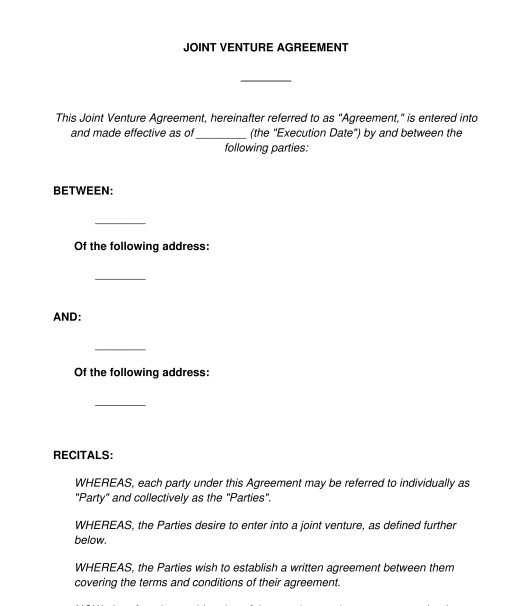 24/09/2025
24/09/2025

Answer a few questions and your document is created automatically.

Your document is ready! You will receive it in Word and PDF formats. You will be able to modify it.

 24/09/2025
24/09/2025
 Word and PDF
Word and PDF
 15 to 21 pages
15 to 21 pages



A Joint Venture Agreement is a contract between two or more individuals or businesses who would like to undertake a new discrete project, start a new service, or do some other type of specific work together in order to make a profit.
Importantly, there are several different structures that joint ventures may take. One of the most common structures is for parties to simply enter a contract together, agreeing to do certain things together. However, in some other cases, parties choose to create a company or some other legal entity together for the sole purpose of undertaking the Joint Venture.
This Joint Venture Agreement does not create a company or any other legal structure. It is simply a contract between the various parties. It says what the parties will do together, and what their various rights and obligations will be.
The term "joint venture" gets used in a number of different contexts. It can apply to many different structures when several parties are planning to work together on a project.
This Joint Venture Agreement is just a contract between several parties. It sets out what the parties will do together, and what their various rights and obligations will be.
On the other hand, a company is a separate legal entity. In some cases, the parties may decide that it is more suitable to set up a brand new company together and to run the joint venture that way.
A Joint Venture Agreement is more limited than a Partnership Agreement. In a joint venture, the parties are only working together for one specific activity (for example, to develop and sell one piece of real estate). A Joint Venture Agreement usually has a defined end point. For example, the joint venture will generally come to any end once the relevant project is complete.
By contrast, in a partnership, the parties may work together on an ongoing basis (for example, by continually buying, developing, and selling different pieces of real estate).
No, it is not mandatory to have a written Joint Venture Agreement. However, it is highly advisable to have one. Having a written Joint Venture Agreement helps protect the interests of all parties. It also helps ensure that the parties understand the terms, are able to cooperate throughout the project, and are able to enforce their rights if an issue arises.
The parties should make sure that their project does not amount to "anti competitive" or "cartel conduct" under Australian competition law. If the parties are normally competitors in their market, and the project is likely to lessen competition, then this is a risk and the parties could risk significant penalties.
The Competition and Consumer Act 2010 (Cth) ("CCA") deals with various anti competitive practices and cartel conduct in Australia. This includes such things as price fixing, output restrictions, market sharing, bid rigging, exclusive dealing and various other actions and agreements in which competing businesses may engage, in order to reduce competition in their market. The CCA prohibits much of this conduct, and imposes significant penalties on businesses that engage in it.
If the parties have any concerns at all about whether or not they are going to be affected by these laws, they should strongly consider obtaining legal advice. This Agreement is only designed for use among parties which are not engaging in anti competitive or cartel conduct. Further information is available on the website of the Australian Competition and Consumer Commission.
This Joint Venture Agreement may be used by two or more parties. The parties can be sole traders, partnerships or companies. They may also use a trust structure if they choose to.
There is no mandatory timeframe for a Joint Venture Agreement. Usually, a Joint Venture is established in order to complete a specific project. Therefore, the joint venture usually terminates when the project is complete.
When this document is ready, it may be signed by all parties and dated. Each party can keep a copy for their records.
No, witnesses are not mandatory for a Joint Venture Agreement, but they are useful for evidentiary purposes. If there is ever a dispute over the Agreement, witnesses can help to prove that each party's signature is valid.
Witnesses should be independent adults (aged over 18), who have the mental capacity to understand what they are doing. They should not be related to one of the parties. This means the parties can not witness each other, and people closely connected to the parties (such as their respective spouses) should not act as witnesses either.
This Joint Venture Agreement should include the following information:
This Joint Venture Agreement will cover all the ground needed for two or more parties or entities to begin a successful new project.
Common law principles of contract law may apply.
In addition, many forms of Joint Venture are also affected by specific legislation in Australia. For example, property developers, companies, and businesses may all be affected by industry specific legislation at the state or commonwealth level.
In addition, in some cases the Australian Consumer Law which is set out in the Competition and Consumer Act 2010 (Commonwealth), may also apply.
The parties may risk breaching the cartel provisions of the Competition and Consumer Act 2010 (Commonwealth) if they propose to engage in any kind of anti-competitive or cartel conduct.
If in doubt, seek legal advice.
You fill out a form. The document is created before your eyes as you respond to the questions.
At the end, you receive it in Word and PDF formats. You can modify it and reuse it.
Guides to help you
Joint Venture Agreement - sample template
Country: Australia